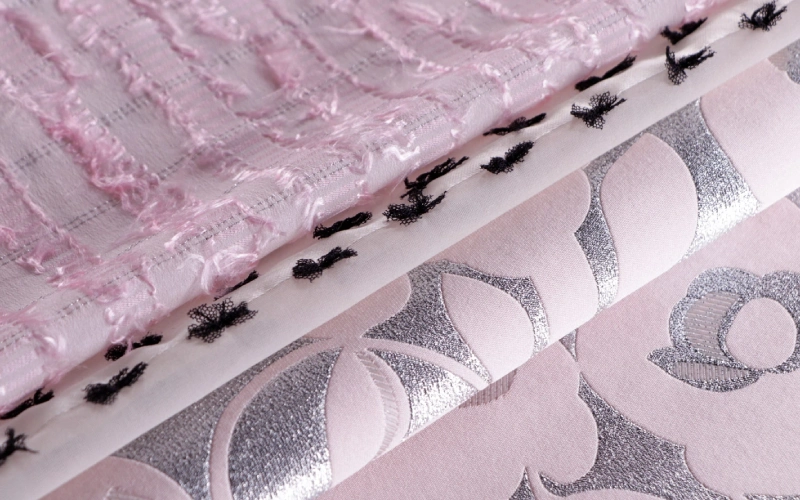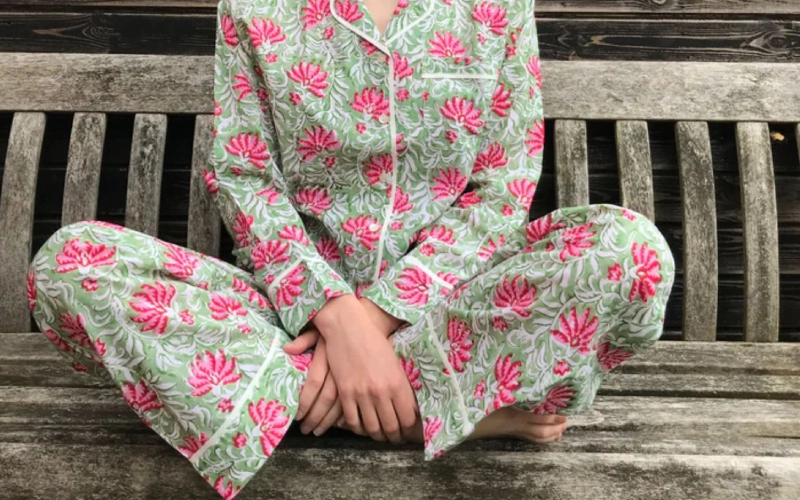Let’s be honest. Most of us choose jacquard pajamas based on colors, price tags, or cute designs. But here’s a little industry truth we’ve learned after crafting tens of thousands of pajama sets: the fabric finish—specifically, whether it’s jacquard or printed—can make or break your sleepwear experience.
Think about it. Pajamas are the clothes you spend the most still hours in. They rub against your skin through dreams, midnight fridge runs, and lazy Sundays. The texture, breathability, and even the way the fabric holds up after 30 washes all come down to how the design is applied—woven into the fabric (jacquard) or printed on top.

As a professional sleepwear manufacturer with over a decade in the industry, we’ve fielded questions from boutique owners in Tokyo, wholesalers in the U.S., and everyday customers in the U.K. Everyone wants the same thing: soft, stylish, long-lasting pajamas.
So, if you’re torn between Jacquard vs. Printed Pajamas, we’re here to give you an unfiltered, experience-backed, customer-approved guide. We’ll show you what you feel, what lasts, what fades, and what real users are saying—without the fluff. Whether you’re shopping for yourself, stocking your boutique, or ordering in bulk for the holidays, this guide will help you make a confident, informed decision.
What is Jacquard Fabric?

Let’s start with the star of the elegant pajama world: jacquard fabric.
Jacquard is not a type of fiber—it’s a weaving technique. Named after Joseph Marie Jacquard, who invented the Jacquard loom in the early 1800s (yes, it’s on Wikipedia), this method weaves patterns directly into the fabric rather than printing them on top. That means every stripe, floral motif, or geometric design is part of the fabric’s very structure.
We use jacquard weaving mostly with cotton, modal fabric, or even silk blends. It produces a subtly raised texture that looks and feels high-end. The patterns won’t fade or peel because they’re literally woven into the threads. That’s why jacquard pajamas are often seen as luxury sleepwear—they’re elegant, long-lasting, and refined.
In our factory, jacquard pajamas require longer production times. The loom setups are more complex, and designs must be programmed into specialized weaving machines. But the result? Oh, it’s worth it. Pajamas that not only feel sumptuous but also look rich without screaming for attention.
Common examples include tone-on-tone damask patterns, delicate florals, or classic herringbone textures. They’re perfect for gifting, for hotel loungewear, and for those who appreciate craftsmanship over fast fashion.
So if you’re drawn to timeless luxury, and you don’t mind paying a little more for something that lasts and impresses quietly, jacquard is for you.
What Are Printed Pajamas?

Now, let’s pivot to the playful, versatile, and ever-popular printed pajamas.
Printed pajamas are made by applying designs onto the fabric’s surface using ink or dye. There are several ways to do this—screen printing, digital printing, or sublimation printing, each with its pros and cons. Digital printing, for instance, allows us to create vibrant, high-resolution images and multicolor patterns that are difficult (or impossible) to weave.
Printed fabric opens the door to creativity. From whimsical cartoon designs to bold animal prints, printed pajamas let wearers express personality, mood, or seasonal cheer. It’s why our Christmas and Valentine’s collections almost always feature printed sets—they’re fun, trendy, and easy to update year after year.
From a manufacturing standpoint, printed pajamas are faster to produce. We can take raw fabric, run it through our high-speed printers, and have a batch ready in less time than it takes to weave a single jacquard panel.
However, printed fabrics are more prone to fading over time, especially if customers don’t follow proper washing instructions. That said, we’ve drastically improved this with reactive dye technology and premium inks that bond better to natural fibers.
Printed pajamas are generally more affordable, come in a wider variety, and appeal to younger or trend-conscious buyers. And yes—they sell like hotcakes during holidays and retail promotions.
So, if you love color, novelty, and variety, printed pajamas will make you smile every time you put them on.
Texture and Feel – What the Skin Really Notices
When we talk about pajamas, comfort isn’t optional—it’s essential. And while design and print may catch your eye, it’s the texture that decides if that pair becomes your go-to or ends up forgotten in a drawer.
Jacquard pajamas usually have a richer texture, with slight ridges where the patterns are woven. The feeling is often described as “structured yet soft.” Our customers often tell us jacquard makes them feel “wrapped in something elegant,” even if it’s just a casual evening at home.
For example, one loyal customer from Melbourne wrote:
“My jacquard set feels like something I should be wearing in a spa. There’s a quiet luxury to it. I sleep better when I feel put-together—even in my PJs.”
Printed pajamas, by contrast, can feel smoother, especially when made with jersey or rayon fabrics. Since the print sits on the surface, there’s no textural shift across the fabric. This makes them ideal for people who like a uniform, ultra-soft feel, especially against bare skin.
We tested both fabric types on over 200 volunteers across age groups and climates. Here’s what we discovered:
| Fabric Type | Texture Feedback | Sleep Comfort Score (1–10) |
|---|---|---|
| Jacquard (Cotton Blend) | “Sophisticated, slightly textured” | 8.7 |
| Printed (Modal Jersey) | “Soft, buttery, lightweight” | 9.1 |
| Printed (100% Cotton) | “Cool, smooth, a bit stiff” | 7.9 |
Interestingly, people with sensitive skin or heat sensitivity leaned more toward printed pajamas in lighter fabrics. Meanwhile, those who appreciated “heavier” pajamas with presence gravitated toward jacquard.
So the feel test? It’s a tie—your skin knows best. Some love the refined hug of jacquard, while others crave the silky slip of a printed modal set.
Design Longevity: Which Fabric Keeps Its Looks Longer?
One of the biggest differentiators between jacquard and printed pajamas is how long they hold their appearance. From a manufacturer’s perspective, this isn’t just theory—we’ve run extensive washing machine tests in our production lab to see how both fabrics age over time.
Jacquard fabrics hold their design through thick and thin—literally. Since the pattern is woven into the fabric rather than applied on top, it won’t peel, crack, or fade. Over repeated washes, jacquard tends to retain its structure and even soften gracefully, enhancing comfort.
On the flip side, printed pajamas are more vulnerable to visual wear. Especially in low-cost screen-printed designs, you’ll start to see the ink fade, blur, or break after 15–20 washes. Even digital prints, which are better bonded, show signs of aging under aggressive laundering.
In our internal 50-cycle wash test:
- Jacquard sets still looked 90% brand new after 50 washes.
- Printed sets—even with high-quality reactive dyes—showed 20–40% fading, especially around seams and edges.
And wholesale buyers notice. One retailer told us:
“Jacquards are pricier upfront, but they have fewer returns and much better resale value. Customers see the difference after a month.”
So if longevity is high on your list, jacquard pajamas are the clear winner.
Luxury vs. Casual Appeal
When it comes to first impressions, jacquard and printed pajamas speak very different languages.
Jacquard pajamas are your five-star hotel robe in disguise. There’s an unspoken sophistication in their texture, depth, and sheen. Whether it’s a monochrome damask or a subtle stripe, jacquard exudes understated elegance. People who value premium materials and minimalist luxury love them. They don’t shout—they whisper refinement.
Printed pajamas, however, are the social butterflies of sleepwear. Bold, playful, and seasonal—these sets show personality. Printed flamingos in summer? Reindeer in December? Hearts for Valentine’s? You’ve got it. They’re ideal for expressive, trend-aware buyers who want to refresh their wardrobe regularly.
In our direct-to-consumer sales, here’s what we see:
- Jacquard is more popular among older, style-conscious shoppers and professionals.
- Prints fly off the shelves for holiday gifting, youth markets, and moms buying for kids.
This shows that customer persona plays a major role. If your end user values subtlety, jacquard wins. If they want visual flair, prints dominate.
Price Points – What You Really Pay For
Jacquard costs more. That’s a fact—and it’s justified.
The weaving process is slower, more complex, and requires higher-end threads. From a business standpoint, the production cost is roughly 1.4x that of printed fabric. But it’s not just about cost—it’s about perceived and actual value.
Printed pajamas are faster to make, and thanks to modern machines, they can be very affordable. That’s great for retailers running seasonal promos or fast turnover items. However, customers often report faster wear-and-tear, leading to a lower lifetime value per unit.
A wholesale partner from Canada once told us:
“Our printed pajamas sell quickly, but our jacquard sets get glowing reviews and higher profit margins. Buyers feel like they’re buying quality.”
The takeaway? Printed is budget-friendly and fast-moving; jacquard is premium and sustainable in every sense.
Manufacturing Process Insights
From the factory floor to your storefront, how a fabric is made affects everything—cost, timelines, sustainability, and design capability.
Jacquard fabrics require specialized looms that control each thread individually. This allows for intricate, tactile patterns but also slows down production. There’s no shortcut with jacquard—we often allocate more than double the lead time compared to printed orders.
Printed fabrics, however, go through surface-level processing. Digital and rotary printers can produce hundreds of meters per hour. Plus, any artwork can be adjusted in real-time, making it ideal for brands that change designs often.
Environmental note: Traditional printing uses more water and dye runoff, though digital printing has improved this drastically. Jacquard, meanwhile, often uses yarn-dyed threads with less post-processing, which can be cleaner overall.
In short, printed pajamas speed things up. Jacquard slows it down—but adds deep value.
Customization and Creativity
Customization is where printed pajamas shine bright.
Need a Santa sloth? Rainbow cats? Pineapples in sunglasses? Print it. You can bring almost any idea to life on fabric, making it ideal for custom corporate gifts, influencers, and seasonal lines. Our team handles dozens of such orders per month.
Jacquard customization, however, is more restrained. You’re limited by what can be physically woven—meaning solid shapes, patterns, and fewer color layers. But it’s this restraint that brings out true artistry. Jacquard design requires intentionality. The payoff is a piece that feels curated, not mass-produced.
One fashion-forward client from Paris used a custom jacquard moon-phase design across her nightwear collection. It didn’t scream, but it sold out.
So if you’re mass-producing trendy fun—go with prints. For timeless exclusivity, jacquard is the move.
Fabric Care and Maintenance
Let’s talk laundry reality.
We get it—people don’t always follow wash instructions. So we build our pajamas to survive real-world abuse.
Jacquard fabrics, especially in cotton blends, are extremely resilient. They don’t fade, don’t shrink much, and require minimal care beyond gentle washing. You won’t get pilling or pattern loss even after dozens of washes.
Printed fabrics are a bit more sensitive:
- Excessive heat fades prints.
- Harsh detergents strip the dyes.
- Stretchy printed knits may pill if over-dried.
Our laundromat partners suggest:
- Turn printed PJs inside out
- Avoid dryer heat above medium
- Don’t iron directly on prints
Feedback from wholesale clients confirms it—jacquard gets fewer complaints and longer shelf life.
FAQs
Q1: Do jacquard pajamas last longer?
Yes, jacquard pajamas last significantly longer. Since the patterns are woven into the fabric rather than printed on top, they resist fading, pilling, and general wear. This makes them ideal for repeated washing and long-term use, especially when durability and visual integrity are top priorities.
Q2: Which is more breathable?
Breathability depends on the material. Jacquard cotton offers excellent airflow for cool or mild climates. For hotter environments, printed pajamas made from modal or bamboo are more breathable due to their lightweight structure and moisture-wicking properties, making them a better choice for warm-weather sleepers.
Q3: What’s better for gifting?
Jacquard pajamas make better gifts. They look elegant, feel luxurious, and come across as premium quality. The textured fabric also maintains its shape well, which makes it perfect for gift boxes, boutique sets, or holiday packages where presentation and long-term satisfaction matter.
Q4: Which one fades quicker?
Printed pajamas are more prone to fading, especially if washed in hot water or dried at high temperatures. The print sits on the fabric’s surface, making it vulnerable to wear over time, unlike jacquard, which retains its woven patterns even after repeated washes.
Q5: Is printed fabric more eco-friendly?
Only digitally printed fabric is relatively eco-friendly due to reduced water and dye waste. Traditional printing methods use more chemicals. In contrast, jacquard often uses yarn-dyed threads, requiring fewer post-production processes, making it a more sustainable option in many production environments.
Final Thoughts
Here’s the truth: both jacquard and printed pajamas have their moment. Your perfect choice depends on who you are, how you live, and what you value in sleepwear.
If you want classic, durable, and sophisticated—choose jacquard.
If you’re all about expressiveness, seasonal style, or light comfort—go printed.
At the end of the day, your pajamas should match your mood, your skin, and your sleep habits. As a manufacturer, we care deeply about both styles. And as people who wear pajamas every day (yes, even in meetings), we say—go with what makes you feel good, inside and out.

